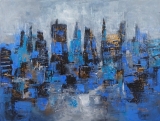Landscape art, with its roots reaching deep into the annals of artistic expression, stands as a testament to humanity's connection with the natural world. From the serene pastoral scenes of the 17th century Dutch Golden Age to the awe-inspiring landscapes of the Hudson River School in 19th century America, this genre has evolved, capturing the ever-changing relationship between humans and their environment.
 Waking metropolis II, Kalpana Soanes
Waking metropolis II, Kalpana Soanes
The genesis of landscape art can be traced back to the desire to document and celebrate the beauty of nature. Early practitioners, such as the Chinese and Persian artists, imbued their landscapes with a spiritual essence, emphasizing the interconnectedness of humanity and the natural world. However, it wasn't until the Renaissance that landscape art began to emerge as an independent genre in Western art.
In the 17th century, Dutch painters like Jacob van Ruisdael and Aelbert Cuyp embraced landscape art, depicting the bucolic countryside and seascapes with meticulous detail. Their works often conveyed a sense of tranquility, celebrating the everyday beauty found in the rural landscapes of the Netherlands.
The 19th century witnessed the rise of the Hudson River School in the United States, a group of artists who sought to capture the grandeur of the American wilderness. Figures like Thomas Cole and Albert Bierstadt painted sweeping vistas of untouched landscapes, emphasizing the sublime and encouraging a sense of awe and reverence for the untamed beauty of the continent.
Impressionist artists, such as Claude Monet and Camille Pissarro, brought a new perspective to landscape art in the late 19th and early 20th centuries. Their emphasis on capturing the transient effects of light and atmosphere revolutionized the genre, introducing a more subjective and emotionally charged approach to depicting nature. Fast forward to the contemporary art scene, and landscape art continues to evolve. Artists like Anselm Kiefer and David Hockney have pushed boundaries, using the landscape as a canvas for exploring complex themes, from memory and identity to the impact of human intervention on the environment.
Beyond the canvas, landscape art has found new expressions in various mediums, including photography, sculpture, and multimedia installations. Environmental artists like Andy Goldsworthy create ephemeral works that interact with the natural environment, underlining the impermanence of our surroundings.
Landscape art, in all its iterations, serves as a visual chronicle of our evolving relationship with nature. It prompts viewers to contemplate the beauty of the world around them, fostering a deeper appreciation for the environment and a recognition of the delicate balance between humanity and the natural world. As we traverse through the brushstrokes of time, landscape art remains a timeless tapestry, weaving together the threads of our collective connection to the earth.
 Waking metropolis II, Kalpana Soanes
Waking metropolis II, Kalpana Soanes